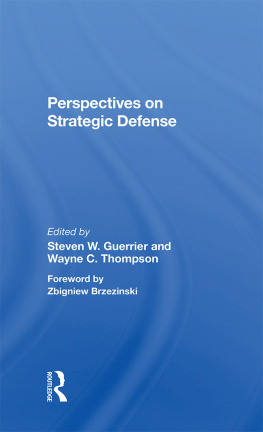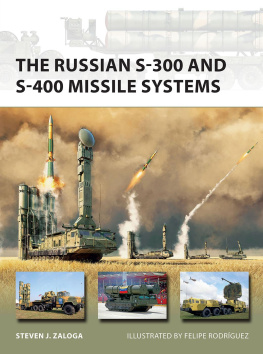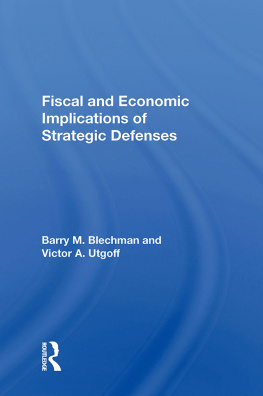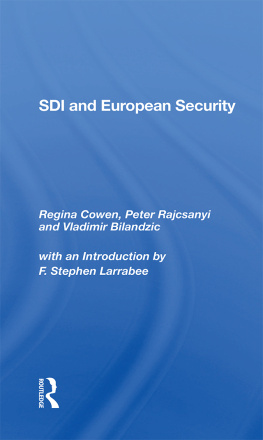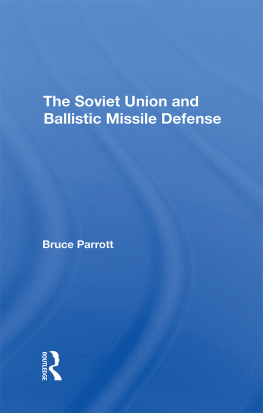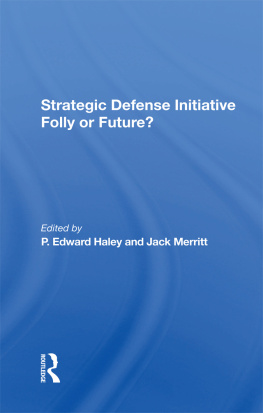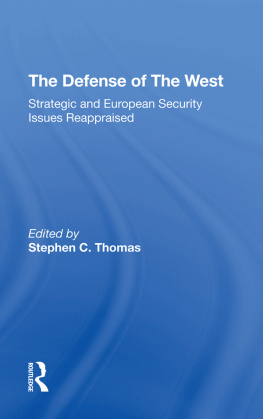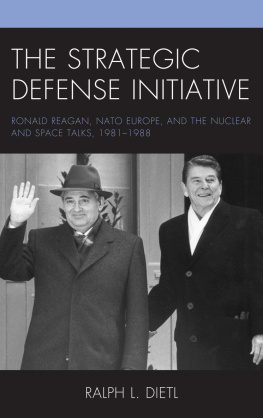Perspectives on Strategic Defense
About the Book and Editors
Bringing together proponents and opponents of the Strategic Defense Initiative, this book includes original essays by leading experts on every aspect of the issue. The collection provides a valuable introduction to the many complex questions involved in any serious consideration of the SDI. The contributors explore such issues as the strategic implications of the SDI, the technical feasibility of the proposal, its impact on U.S.-USSR relations and the arms control process, and the response of NATO allies to the program.
The book also includes a detailed history of the strategic defense debate, policy statements by the key political players, and petitions on its technical flaws and arms control implications that have been signed by U.S. scientists. A comprehensive glossary and index make this book a valuable reference tool.
Steven W. Guerrier is assistant professor of military and diplomatic history at the Virginia Military Institute. Wayne C. Thompson is associate professor of political science at the Virginia Military Institute and specializes in European politics.
Perspectives on Strategic Defense
edited by Steven W. Guerrier
and Wayne C. Thompson
Foreword by Zbigniew Brzezinski
First published 1987 by Westview Press, Inc.
Published 2019 by Routledge
52 Vanderbilt Avenue, New York, NY 10017
2 Park Square, Milton Park, Abingdon, Oxon OX14 4RN
Routledge is an imprint of the Taylor & Francis Group, an informa business
Copyright 1987 Taylor & Francis
All rights reserved. No part of this book may be reprinted or reproduced or utilised in any form or by any electronic, mechanical, or other means, now known or hereafter invented, including photocopying and recording, or in any information storage or retrieval system, without permission in writing from the publishers.
Notice:
Product or corporate names may be trademarks or registered trademarks, and are used only for identification and explanation without intent to infringe.
Library of Congress Cataloging-in-Publication Data
Perspectives on strategic defense.
(Westview special studies in national security and
defense policy)
1. Strategic Defense Initiative. I. Guerrier,
Steven W. II. Thompson, Wayne C., 1943- . III. Series.
UG743.P47 1987 358'.1754 86-22430
ISBN 13: 978-0-367-28275-2 (hbk)
To Nancy and Susie
Contents
by Zbigniew Brzezinski
Steven W. Guerrier,
James A. Abrahamson,
Spurgeon M. Keeny, Jr.,
Edward Teller,
Peter A. Clausen,
Gregory M. Suchan,
Jack Mendelsohn,
Sergei Kislyak,
Louis Marquet,
George W. Rathjens,
Louis Marquet,
Steven A. Maaranen,
Barry M. Blechman,
Pierre M. Gallois,
Jacquelyn K. Davis,
Joel J. Sokolsky and Joseph T. Jockel,
Ronald Reagan,
Paul H. Nitze,
Ronald Reagan,
Ronald Reagan,
Richard N. Perle,
Geoffrey Howe,
Michael Heseltine,
Brian Mulroney,
Mikhail Gorbachev,
Guide
Zbigniew Brzezinski
Four years have passed since President Reagan launched the Strategic Defense Initiative. The resulting debate has afforded us a unique opportunity. The United States is on the verge of a fundamental development in strategic weapons technology. In the past, technological development in the area of strategic weapons ran ahead of our ability to assimilate their implications for national strategy. The invention of nuclear weapons in the forties preceded serious discussion of the impact of nuclear weaponry on war and peace. For the next two decades, we engaged in a continuous debate about the role of nuclear weapons in our national strategy. Leaving aside for the moment the desirability of the subsequent development and deployment of a strategic defense, we are in a position that gives us the opportunity to engage in a kind of strategic re-evaluation, re-thinking, and re-development of our strategic doctrine that would make whatever decisions we eventually make about the SDI part of a coherent long-range strategy.
It is my view that the Strategic Defense Initiative provides the United States with the means of achieving mutual strategic security, either through a bilateral arms control agreement with the Soviet Union or through a unilateral deployment of a limited strategic defense. Our willingness to explore the possibility of building a strategic defense creates enormous leverage to induce the Soviets to accept in negotiations significant cuts in offensive nuclear forces, particularly those that are accurate and powerful enough to destroy hardened targets in a first strike. It is imperative that the United States continue with a vigorous research and development program for its negotiating position to appear credible. This program should be directed toward those defensive systems that can be developed in the near term to defend our retaliatory forces and command system. At the same time, this view implies that the United States must be willing both to limit the scope of its strategic defenses as part of an agreement and to take soon the initial deployment decisions in favor of a two-tier limited strategic defense system. Thus, if the negotiations succeed or fail to reach a stabilizing agreement, our strategic retaliatory forces will be more secure.
In this volume, Professors Steven Guerrier and Wayne Thompson have made a valuable contribution to the debate over strategic defense. Based on conferences at the Virginia Military Institute in the spring and fall of 1986, this book includes important insights on the SDI issue from prominent figures on both sides of the debate, as well as a transcript of a lengthy discussion session among these experts and a section that reproduces several official government policy statements. This debate, of course, will not end here, but our understanding of the fundamental issues involved with the SDI will surely be enhanced.
The debate over the Strategic Defense Initiative touches on the very survival of our nation and of mankind. How can we best be protected from atomic annihilation? Through defensive weapons, mutual vulnerability to offensive nuclear weapons, negotiated arms reductions, or some combination of these?
In a speech before the House of Commons on March 1, 1955, Winston S. Churchill said in reference to the policy of nuclear deterrence: "It may well be that we shall by a process of supreme irony have reached a stage in this story where safety will be the sturdy child of terror, and survival the twin brother of anihilation." Over four decades, nuclear deterrence has been the basis for keeping peace in the atomic age. Both sides have maintained swords, but no real shields. Is this approach now outdated? Is it time to attempt to render the nuclear threat impotent and obsolete by technical means? Would SDI undermine or strengthen the deterrence of war?
The Corps of Cadets at the Virginia Military Institute considered these questions to be so important that on April 7-8 and October 16-17, 1986, it organized two symposia on the subjects of SDI and the use of outer space. The participants, who represented widely divergent points of view, discussed the key elements of the debate over SDI: what it is and why it was proposed; its technical and financial feasibility; the response to it by the Soviet Union and America's allies; its impact on the United States's strategic doctrine and on arms control negotiations; and whether, in sum, SDI brings us hope or danger, stability or instability, peace or war. The presentations and discussions at those conferences provide the backbone of this book.


